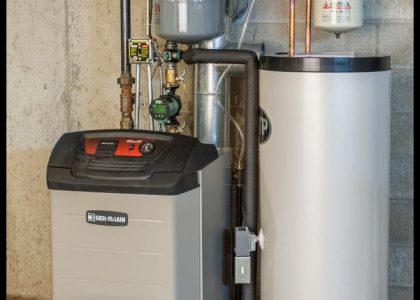Legally, Plumbing & Heating Technicians are required to set the DHW (Domestic Hot Water) temperature at a maximum of 120 Degrees Fahrenheit at the faucet(s) (taps). The purpose is simple, to prevent personal injury particularly of children and when operating any water tap. It works, but is it ideal for the residential or commercial user? No.
Like any regulation it has up and down sides. The down side is that some dedicated appliances need higher water temperatures or you pay it back in poorer performance and increased electrical energy costs. Dishwashers and commercial power washers are the primary examples.
Commercial Dishwashers require a continuous 140 Degrees Fahrenheit supply to assure bacterial elimination and augment the sanitation cycle (electrical enhancement). We have had more than a few instances where clients have not been able to meet State Health Dept. Guidelines. In all cases there was a misapplication of DHW heating equipment involved. Shouldn’t a similar situation exist with residential DHW generation? It does.
Examples:
-
Local Dealer installed a Rinnai Demand Water Heater to supply a commercial dishwasher in a restaurant. Rinnai and others supply up to a 120 Degree F output as shipped. There is an internal switch to increase this to 140 Degrees F — and immediately void your Warrantee. There is a product application disclaimer on these and other Demand Heaters specifically excluding commercial dishwashers and other similar applications. Moreover they will not supply the volume of water over time (the Delta-T Problem). The only potential solution is to supply tempered water to the heater (see other blogs), but this can be iffy even for this application.
-
Area Church installed a gas-fired 40 gallon water heater to supply their commercial dishwasher. Even if you could force the temp up to 140, there is not enough stored and resupply volume to operate through cycle(s). Being a single DHW source in a public structure, then what do you then do about tap water temperatures?
Now, what about your residential dishwasher? The same process applies with similar results — but you don’t see it readily. That 120 Degree F (at best) water does its thing, but not as efficiently. Your initial wash temperature is low and efficiency suffers. The electricity-sucking water temp coil and sanitizing cycles are notorious energy users. (Look at the Wattage Data on the Appliance Nameplate.)
The obvious solution in all cases is to supply hotter water to all dishwashers. In one manner or another you must provide a dual temperature source to accomplish this. The techniques vary depending upon your DHW source:
-
Electric, Gas&Oil-fired and Indirect DHW Heaters – Increase your thermal switch or aquastat temps up to 140 Degrees F (the usual max allowable by design). Then separate your piping to the dishwasher (and other?) and install a good quality Tempering Valve into your other tap water supply line(s).
-
Immersion (Tankless) DHW Coil in your Boiler – Ideal situation. Tee the output of your coil to dishwasher (and other?) for maximum temperature water. Careful – it is scalding hot!
-
Provide a separate, high temperature & capacity DHW Heater to suit the particular appliance(s).
Meanwhile do the “cheap tricks”:
-
Insulate all your DHW lines from heater to use points, regardless and inasmuch as possible.
-
Shut off your DHW immersion coil boilers between cycles to save energy during low heating season demands. It only takes about 15 minutes to reheat. Plan ahead.
-
Open the nearest hot water tap to your dishwasher (kitchen sink?) to get water hot before cycling your dishwasher. This will minimize that initial wash temperature problem in the dishwasher.
If you should decide to employ high temperature DHW taps for specialized use, do it safely. Secure them!
Last Edit: 10/10/2012 pdm

